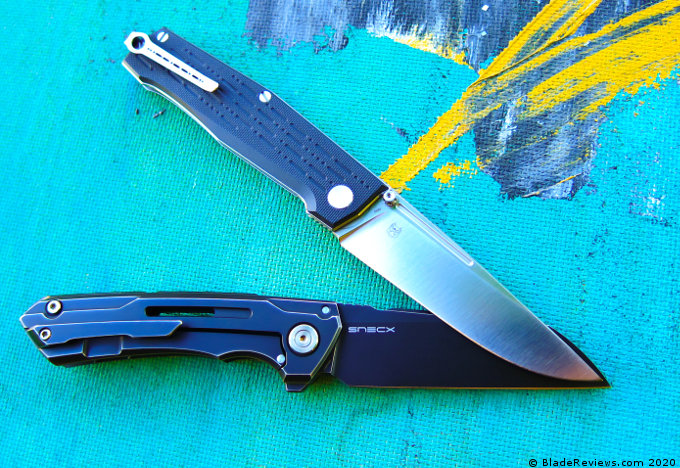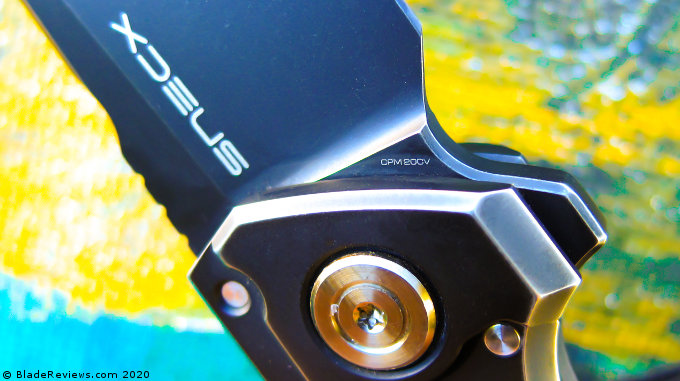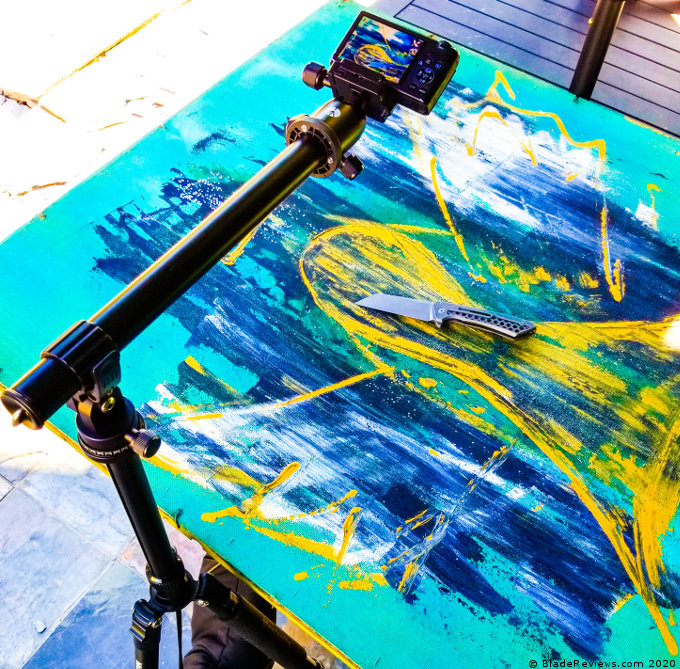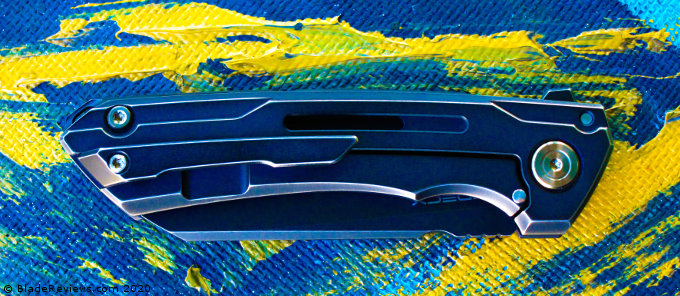This post contains affiliate links. We may get paid an affiliate commission if you buy something or take an action after clicking one of the links on this web page.
Snecx! If you haven’t heard of him yet, Snecx Tan is a Malaysian knife and tool maker who is, in my opinion, currently the most mechanically innovative knife designer in the world. His Instagram profile says “Just a hobbyist working on knives. Not a knifemaker.” That’s a bit of an understatement for someone who recently held an auction on Instagram for the one-of-a-kind prototype of his upcoming “Vision S” knife. It sold for $18,900.00 USD. That’s a pretty well-funded hobby.

Buy the Mini Buster at BladeHQ or GP Knives
There are a lot of knife enthusiasts like myself who have been eager to get our hands on a reasonably priced Snecx knife, and WE Knife Co. has delivered with the Mini Buster, which goes for $289. I’ve been using it every day for the last month, and here’s what I’ve learned: it’s a nearly perfect large-ish EDC knife with one major design flaw.
General Dimensions and Blade Details
The Mini Buster is 4.5” (115 mm) closed, 7.8” (198 mm) open, and has a 3.4” (86 mm) blade made of CPM-20CV steel. The blade stock is 4 mm thick at its widest point, and the handle is about half an inch thick (13 mm) not counting the clip, which adds another 4.5 mm. So it’s no slim little Brad Zinker disappear-in-your-pocket folder, but it’s also no Cold Steel supersized monster knife either.

The blade is a very slightly curved sheepsfoot style, which I consider to be the ideal do-everything EDC blade shape. Its tip is pointy enough to pierce tough materials, and the blade is wide enough to use as a butter knife. I prefer the ergonomics of a
sheepsfoot (or wharncliffe) blade over a traditional drop point blade because, when holding the knife with my index finger on the spine of the blade to open a box, the low tip of the sheepsfoot blade keeps my wrist and arm at a more comfortable angle than when using a drop point blade.

The picture above illustrates how the Mini Buster’s sheepsfoot blade tip can cut while nearly parallel to a surface, while the drop point blade on the RealSteel Rokot needs to be at a much higher angle to utilize the tip of the blade.
The WE Mini Buster’s blade stock is Crucible CPM-20CV steel, which is a premium American-made blade steel with extremely high hardness and above-average toughness. To avoid taking an unnecessarily deep dive into metallurgy, I will just say the Mini Buster’s blade has excellent edge retention, but is more likely to chip than bend.

CPM-20CV is nearly identical to the European-made Bohler M390 steel, and these powdered-metallurgy “super steels” are THE go-to blade steels for high-end knives lately. In fact, of the 14 folding knife reviews BladeReviews.com has published so far in 2020, 35% of them had CPM-20CV or M390 blades. They’re great knife steels, and I’ve noticed that I need to sharpen my D2, CPM-154, and RWL34 knives more often than my harder steel M390 or 20CV knives.
Over the past month, I’ve been hacking away at everything in my vicinity that can be hacked at, including thick plastic packing straps, cardboard, annoying clamshell packaging, stray tangerine tree branches, and, when trying to cut a piece of baklava in half, I sliced up a metal catering pan. Despite all that, I have yet to scratch the blade’s black DLC coating or the handle’s anodizing. That’s quite impressive considering that I normally scratch my DLC coated steel blades and anodized titanium handles almost immediately.
The blade’s primary grind angle is known as a “flat” grind, which looks like a narrow symmetrical “V”.

In the kitchen, the blade’s uninterrupted “V” shape had no contours or additional angles to disrupt its slicing path through a bunch of tomatoes and cucumbers. As with nearly every folding knife, the Buster’s blade/handle configuration doesn’t allow food dicing without rapping my knuckles on the cutting board with every downstroke. Snecx tested the durability of his original Buster knife by slashing the tops off of green coconuts- I think the Mini Buster could handle that task, but it would definitely be easier with a non-Mini Buster…
I’m a pretty frugal guy, but I’m impulsive when it comes to my steel and/or gunpowder-related hobbies. It also usually takes me making the same mistake two or three times before I learn my lesson. For example, I’ve watched myself compulsively click the “buy” button on some limited-edition knives that I thought looked cool: a Dervish Knives Alchemy midtech ($395) and a Prometheus Design Werx/Strider Knives SMF “Frogskin” ($635). But my biggest impulse buy of all was in 2018 when I bought a Snecx/Jake Hoback Knives collaboration Buster ($775), which is the most I have ever spent (or ever will spend) on a knife.

Like my first marriage, I always knew I was making a mistake but went ahead with it anyway. I immediately regretted my decision- I didn’t really like them, I wanted to sell them (the marriage analogy definitely no longer applies from this point on), and so I never carried or even enjoyed them. I managed to sell the Dervish and the Strider at a loss, and I’ve tried to sell the Snecx/Hoback Buster twice with no takers. In early 2020 I saw one in the BladeHQ closeout section for $499. Maddening! I’m done with buying expensive knives.
A brief history of the Snecx/Jake Hoback Knives Buster: Snecx is indeed a knifemaker (despite his claims to the contrary) but is not a knife manufacturer, so in 2018 he launched two collaboration projects. The first was the Custom Knife Factory Terra, and the second was the Hoback Buster. According to what I’ve read on Snecx’s Instagram and Hoback’s website, Snecx’s core visual design was minimally modified, but a lot of details were changed, most notably the addition of a honeycomb pattern in the handle.

I definitely appreciate innovation and unique aesthetics, but (sorry Mr. Hoback!) I think it ended up looking like a mashup of two contrasting, not complimentary, design styles. Plus it’s huge. I give zero fucks about what the general public considers an “office-friendly” or non-scary looking knife, but the Hoback Buster is so big and heavy that it’s unwieldy.

I was surprised to see that the Hoback Buster isn’t much bigger or heavier than my Chris Reeve Knives Large Sebenza 21 (an expensive knife that I’ve never regretted buying) but in the hand, the Hoback Buster is a big manly beast knife. OK- out of the shame spiral and back to the review.
Handle, Ergonomics, and Pocket Clip
The Mini Buster feels great in use, even though I can’t quite get a full four-finger grip with my medium-large hands. The handle is long enough overall, but the upswept end of the bottom of the handle (see arrow in picture above) removes some finger gripping space. The pad of my pinky finger ends up on the handle screw near the lanyard loop, and that’s enough for me to achieve a secure grip with all four fingers.
When held in a regular grip with my thumb on the spine, my thumb naturally rests in a little indentation where the backspacer ends above the pivot, but I can also comfortably shift my thumb forward onto a section of jimping on the blade spine if I want more precise control of the blade.

The jimping ends in a stylish little dip for the tip of my thumb, which is one of four places (see arrows in picture above) on the Mini Buster where Snecx used this dip-in-a-straight(ish)-line design cue.
The Mini Buster also has a number of subtle angular details, which are definitely accentuated by the artificial edge wear of the “antique bronze” finish version I bought. There are almost no straight lines on this knife. There’s an almost subliminal curve to every part of the Mini Buster, including the blade, which has a very slight belly. Another interesting design choice on the WE Mini Buster is how the angular front tip of the handle crosses the plunge line of the blade. This is a carryover from the original Snecx Buster design.

According to Snecx, he allowed Jake Hoback to “fix” the handle angle and plunge line so they’re parallel. You can see this difference between the two knives in the picture above. But when WE Knife Co. did the same “fix” to an early Mini Buster prototype, Snecx made them retain his original Buster handle/plunge line design.
Deployment and Lockup
The Mini Buster is a framelock with a unique Snecx twist: the H.D.P.S. system. That stands for Hybrid Detent Pin System, and my admittedly limited understanding of it boils down to this: the shiny round steel pin on the lockbar (see picture below) acts as both the stop pin, which keeps the blade locked into its open position, and as the detent ball, which keeps the blade in place in its closed position.

I can’t be sure if this is a function of the HDPS system, but the Mini Buster does a far better job than most other knives of easily opening while there’s pressure on the detent. I can squeeze the lockbar section of the handle (the part attached to the aforementioned shiny round steel pin) pretty hard without hampering my ability to flip open the knife. Snecx, however, isn’t the only recent innovator on this front. Zero Tolerance Knives recently released the 0707 framelock, featuring their new Tuned Detent System, which is designed to address the same problem, but using a different mechanical approach. I watched a video review of the 0707, and although it does an admirable job of opening irregardless of pressure on the lockbar, it does not smoothly swing shut like the Mini Buster.
I only have one criticism of this knife, and this is the major design flaw I alluded to at the beginning of this review: the little tiny nubby flipper tab becomes completely inoperable if your finger is even slightly wet or slippery.
Why? The face of the flipper tab is completely smooth, without any machined texturing like most flipper-actuated knives have. That in itself isn’t necessarily a problem, but it’s also so small there’s barely any surface area for your fingertip, so a single drop of water will defeat any attempt to flip open this knife. In my wet and slippery kitchen and gardening adventures with this knife, I found that the only way to open the Mini Buster was to pinch the spine of the conveniently “V” shaped blade and manually pull it open.
Snecx is known to be an absolute perfectionist, so I don’t understand how there could be such an obvious problem like this. According to what I saw in Snecx’s Instagram posts about the WE Mini Buster, he seemed quite pleased with it, so my theory is this: the lack of flipper leverage (a conscious design choice) was deliberately compensated for by using a somewhat weak detent. The detent, which in this context is the wall of force that my index finger on the flipper tab must overcome to deploy the blade, isn’t quite strong enough to guarantee the knife completely opening every time. I suspect that the detent was made as strong as was possible given the limited leverage on the flipper tab. That’s not a huge deal, but it does require more concentration and effort to deploy the blade than is required for most knives in this price range. I’m probably overthinking all of this, but I have seen several other people mention their knives have a weak detent, so it’s possible I’m right.
Nonetheless, once the blade gets going, the ceramic ball bearings surrounding the pivot give it a smooth and easy action. It locks open with a confidence-inspiring snap, and in use it feels as solid as a fixed blade knife.
We Knife Co. Mini Buster Review – Final Thoughts
Even with it’s flipper design issues, I stand by my initial claim that this is a nearly perfect large-ish EDC knife. According to Snecx, it’s also his final framelock design. He’s moved on to his “Vision” knife, for which he has invented two new technologies: the Superlock locking system, and the Zero Flex Pivot. It became very obvious to me that Snecx was onto something special when heavy-hitter designers like Ostap Hel, Rotten Design, and Tashi Bharucha all publicly commented on the same Instagram post about Snecx’s Zero Flex Pivot. Tashi B’s comment just said “Perfection”. The Vision looks amazing, but that doesn’t matter to me at all, because as I said, I’m absolutely done with buying expensive knives.
UPDATE: I bought a $160 titanium COVID tool.

It’s a very limited edition (only 15 pieces) handmade by one of my favorite knife designers, Tashi Bharucha, in partnership with his frequent collaborator Thierry Savidan. It’s part of a series called “The Good, The Bad, and The Ugly”. I bought “The Good” (pictured above), but did not get “The Bad”, which is the same design but with three knuckle spikes. Both versions came with a little COVID-19 shaped lanyard bead engraved with the words “THE UGLY”.

Like my Hoback Buster, it’s huge and expensive, especially compared to my $17 Civivi copper COVID tool also pictured. Unlike my Hoback Buster, however, I have NO regrets about buying this thing- it’s awesome and I smile every time I whip it out to open a door or punch in my PIN number.
Finally, the Hoback Buster that I’ve been whining about for the entire review is still for sale! Hit me up in the comments or on Instagram if you want to make this “As seen on BladeReviews.com” Hoback Buster all yours…

Thank you to Sara O’Neil for the use of her painting.

We Knives Mini Buster – From $272.00
From: BladeHQ
Editor: I recommend purchasing the We Knives Mini Buster at BladeHQ or GP Knives. Thank you very much.


Leave a Reply